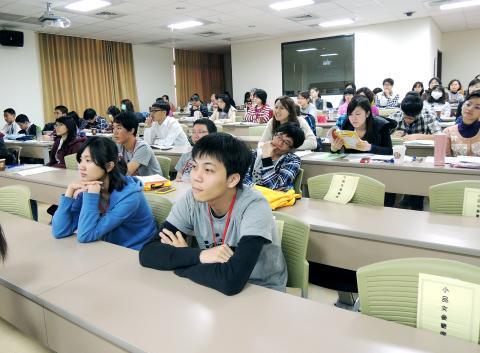Why are students so reticent in class? According to a recent study conducted by researchers from National Taiwan Normal University (NTNU), National Tsing Hua University (NTHU) and Taipei Municipal University of Education (TMUE), students are reluctant about asking questions or responding to questions in the classroom because they fear losing face. The study also found that Taiwanese students are culturally conditioned to learn passively, without asking or answering questions verbally.
NTU professor Fwu Bih-jen says that the advantage of Taiwan’s teaching methods is that students learn by memorizing and practicing, which gives them a firm foundation. This competitive edge is most apparent when looking at how Taiwanese students rank in overall educational performance in international evaluations, including the Trends in International Mathematics and Science Study (TIMSS) and the Programme for International Student Assessment (PISA), Fwu says, adding that this advantage also provides capable talent to the original equipment manufacturing (OEM) sector. For the future, however, she says that Taiwan will need more innovators, people who can think critically and analytically. Taiwanese students typically do not perform as well in areas covering these higher cognitive skills in TIMSS and PISA, which explains why they show less overall proficiency in those areas.
The National Science Council commissioned researchers from NTNU, NTHU and TMUE to study university students in the classroom. The results of the study showed that 83 percent of students were accustomed to recitation and rote learning, while only 28 percent were willing to interact with teachers during class and 36 percent were willing to participate in class discussions and ask questions. The main reason for this paucity of participation is ostensibly because Taiwanese students are generally afraid of losing face and because the majority of their past learning experiences consisted of teachers lecturing without students asking questions during class.

Photo: Tsai Shu-yuan, Liberty Times
照片:自由時報記者蔡淑媛
Wei Chih-fen, head of TMUE’s Department of Psychology and Counseling, says that the more afraid a student is of losing face, the less inclined that student is to answering questions, but that students are much more willing to ask questions in class if they feel confident that they have a worthy question that could gain them affirmation from teachers and students by showing their potential.
(Liberty Times, Translated by Kyle Jeffcoat)
為什麼學生在課堂上總是靜悄悄?原來是怕問到笨問題或答錯問題而「沒面子」!台灣大學師培中心、台北市立教育大學與清華大學共同合作研究發現,我國文化脈絡下的學習模式,「教」的意涵是「上所施,下所效」,不強調提問與回答。
台大教授符碧真表示,我國學習模式的優勢是學生透過記憶及練習,吸收知識,學識基礎扎實,這可從我國學生多次國際學術評比如國際數學與科學成就趨勢調查(TIMSS)及國際學生評量方案(PISA)整體表現優異或可為證,提供了代工所需人力。但未來發展需要創新人才,需要思辨與探究的能力,我國在TIMSS及PISA評比高層次能力表現較差,說明學生這方面的能力較弱。
國科會委託台灣師範大學、清華大學以及台北市立教育大學研究大學生上課情形,發現高達百分之八十三的大學生修課經驗是「記誦與練習」,只有百分之二十八的學生願意在課堂上與老師互動,百分之三十六願意參與課堂討論與發問,主要原因是台灣學生愛面子,且過去的學習經驗多半是老師單方面教授知識,學生沒有在課堂上發言的習慣。
台北市立教育大學心理與諮商學系主任危芷芬表示,學生愈擔心面子問題,回答意願就越低,但若覺得問出好問題,能展現自己潛能獲老師與同儕肯定,回答意願就愈高。
(自由時報記者湯佳玲)

A: Happy New Year! I can’t believe it’s 2026 already. Where did you count down? B: I went to pop singer A-mei’s Taitung concert yesterday for the New Year’s countdown. How about you? A: I went to rock band Mayday’s Taichung concert yesterday. Going to their New Year’s shows has become a holiday tradition for me. B: Don’t forget, we’re also going to Jolin Tsai’s show tonight. It’s her first perfomance at the Taipei Dome. A: Yeah, that’s right. It’s great to start the year with good friends and good music. A: 新年快樂!我真不敢相信都已經2026年了。你昨天去哪跨年啦? B: 我昨天去了流行天后張惠妹的台東演唱會,還和她一起跨年倒數。那你呢? A:

Prompted by military threats from Russia, Denmark has recently passed a new conscription law, officially including women in its military draft for the first time. From July 1, 2025, Danish women, upon turning 18, will be entered into the draft lottery. If selected, they are to serve in the military for 11 months, just as men do. Not only has this decision attracted international attention, but it has also sparked discussions on gender, equality and national defense. Although Denmark’s reform appears to promote gender equality, it primarily responds to regional instability and the need to strengthen national defense. With

A: Apart from Taiwan’s A-mei, Mayday and Jolin Tsai, there are many foreign singers coming to Taiwan early this year. B: The South Korean girl group Babymonster are playing two shows at Taipei Arena starting from tonight. Who else is coming to Taiwan? A: Other artists include Australian band Air Supply, K-pop superstar Rain, boy group Super Junior, TXT, US singers Giveon and Josh Groban, and Irish boy group Westlife. B: Air Supply was the first foreign band to come to Taiwan in 1983, and they’re probably the most frequently visiting group too. A: As the year is beginning

Kendrick Lamar is a world-renowned rapper with numerous accolades to his name. He has won 22 Grammy Awards and __1__ music charts in countries all around the globe. One unexpected accomplishment he can add to the list is being a lifesaver, thanks to his 2024 hit “Not Like Us.” According to the American Heart Association (AHA), this song has the perfect tempo for performing Hands-Only CPR. Cardiopulmonary Resuscitation (CPR) is a critical lifesaving __2__ used when someone suffers cardiac arrest and their heart stops beating. It aims to maintain blood flow to vital organs until __3__ help arrives. There